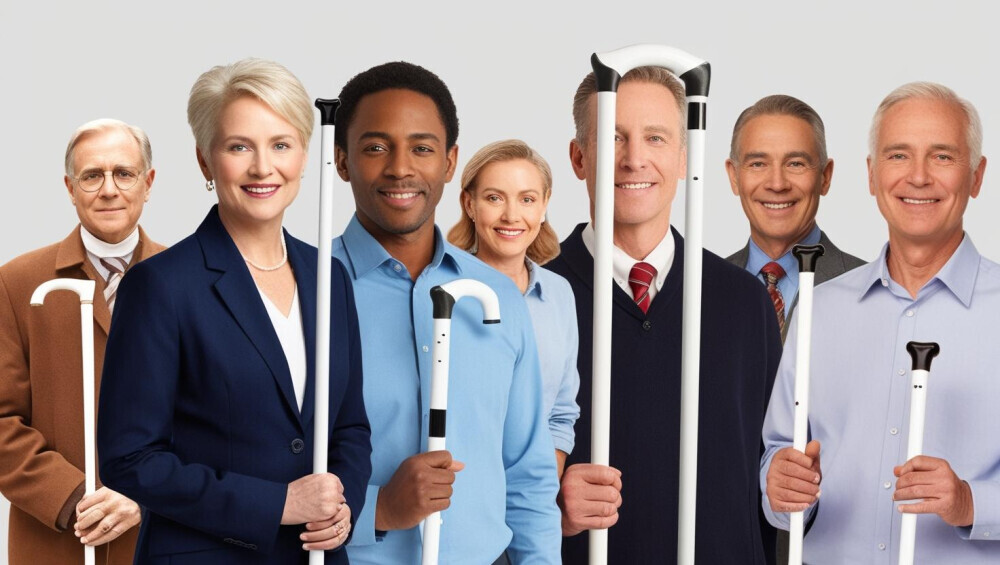
Welcome to my FAQ on white canes for visually impaired individuals. I have gathered answers to questions I often encounter about white canes, aiming to provide clear and useful information for those interested in learning how these tools support independence and safe travel. I have based this content on research and personal understanding to create a guide that addresses common concerns and details essential aspects of white canes.
1: What is a white cane and what role does it play?
A white cane is a mobility tool designed for individuals with visual impairments. I have seen that the white cane is more than just a stick; it serves as both a warning and a guide. Its distinct color signals to others that its user has low vision. The cane helps in detecting obstacles, changes in terrain, and potential hazards in the environment. Because it is lightweight and durable, a white cane allows the user to safely explore their surroundings on foot. I believe this simple tool provides a sense of freedom and independence that many people take for granted.
The design of a white cane usually includes a handle at the top and a long, thin shaft. I have noticed that this design is intended to provide tactile feedback by allowing the user to gently tap or sweep the surface in front of them. This tapping action gives the user time to assess their environment and modify their course if needed. In addition to helping with safe travel, the cane acts as an extension of the body by creating a buffer zone that helps prevent collisions. In my experience, having a tool that alerts both the individual and people around them reduces the likelihood of accidents and injuries.
Many individuals learn to use a white cane as part of orientation and mobility training. I appreciate that training typically includes proper techniques for walking, detecting obstacles, and making safe turns. This training is very important because it turns a simple cane into an effective mobility aid that gives a boost to confidence. Every person who uses a white cane benefits from understanding its full potential. Even as technology and traditional methods mix together and continue to evolve, the fundamental purpose remains unchanged: promoting safe, independent travel.
2: How do white canes improve navigation and support independence?
White canes offer one of the most practical ways for visually impaired individuals to find their way and support independence in their communities. I have observed that one of their key benefits is the increased awareness of the immediate environment. The cane makes subtle changes on the ground more noticeable. For instance, bumps, curbs, and obstacles come to the user’s attention through slight changes in the cane’s movement and sound. These cues enable the person to adjust their steps, which overall boosts safety.
The tactile feedback provided by a white cane builds confidence. I often hear from people in the visually impaired community that they feel more secure when they can physically detect changes in their terrain. This sense of security is something I consider really important for maintaining independence. With a cane, individuals are empowered to travel without needing another person to physically guide them everywhere. Even in busy urban areas or on inconsistent pathways, the cane provides reliable alerts about potential hazards.
This independence goes beyond physical movement. I understand that using a white cane allows those with visual impairments to get more involved with their communities. It opens up possibilities for employment, education, and social interactions, knowing that there is an effective tool available for safe travel. Additionally, community awareness grows when people recognize the white cane as a symbol of visual impairment, prompting them to offer assistance when needed. This increased recognition helps promote a more inclusive environment where everyone can appreciate both the challenges and strengths of those who are visually impaired.
The design considerations of the white cane, from its lightweight construction to its flexible tip, play a very important role in ensuring reliable feedback. I have learned that these design features are vital for preventing accidents and providing the user with more precise control over their movement. The combination of manual control and simple mechanics makes the white cane an ideal tool that many visually impaired individuals trust daily. Its overall contribution to safe mobility and personal independence is evident in every aspect of its use.
3: What types of white canes are available and how do they differ?
There are various types of white canes available, each designed to suit different needs and lifestyles. I have found that they generally come in a few common variants, including straight canes, folding canes, and telescopic canes. Each variant offers unique benefits depending on the user’s circumstances and personal preferences.
The straight cane is the most traditional form. I favor this design because of its simplicity and durability. It is long and typically made from materials such as aluminum or fiberglass, which help in providing clear feedback from the ground. Most users find this type reliable for outdoor use, where consistent contact with the terrain is important for safe travel.
Folding canes are known for their portability and convenience. These canes can be collapsed into smaller segments, making them easier to store and transport in compact spaces. I have noticed that for those who use public transportation or travel frequently, a folding cane offers the best balance between functionality and ease of storage. Despite their compact nature, these canes do not compromise on providing the essential ground feedback when used correctly.
Telescopic canes are similar to folding canes in terms of portability but feature an extendable design. I appreciate this design because it allows for adjustments in length and is useful for people who might require different reaches on different occasions. This adjustable feature is particularly helpful in areas with a mix of open spaces and crowded sidewalks or pathways. The versatility of a telescopic cane makes it a popular choice among many individuals.
There are also canes that incorporate additional features such as ergonomic handles and shock-absorbent tips. I have seen that these design variations aim to step up comfort and ease the physical strain of prolonged use. Although they might cost a bit more, many users value the extra comfort, especially if they rely on the cane for many hours throughout the day. The range of available options allows users to select a cane that not only fits their physical needs but also matches their lifestyle preferences.
4: How should one choose the right white cane?
Choosing a white cane is a personal decision that depends on individual preferences, physical requirements, and daily routines. I have learned that a careful consideration of factors such as length, weight, material, and design is essential. It is beneficial to try multiple types if possible, as personal comfort plays a major role in long-term satisfaction with the tool.
The length of the cane is one of the first aspects to consider. I recommend that the correct length should allow the user’s arm to be slightly bent when holding the handle. This positioning provides the best angle for detecting changes in the ground. An incorrect length may reduce the effectiveness of the cane and cause unnecessary strain over time.
Weight is another important factor. I have seen that lighter materials like aluminum are popular because they reduce fatigue during prolonged use. At the same time, the material needs to be sturdy enough to withstand daily wear and tear. I advise looking for canes that balance a light weight with robustness, ensuring both ease of mobility and long-lasting durability.
Material and build quality also affect the feedback the cane provides. I understand that different materials may change the tactile response when the cane makes contact with various surfaces. A flexible yet responsive tip can help distinguish between different textures and obstacles. I encourage those new to white canes to consult with specialists or to try before committing, ensuring that the tool fits their personal style of walking and everyday needs.
Often, professionals in orientation and mobility training can offer valuable insight into choosing the right instrument. I have found that these specialists assess an individual’s requirements and provide recommendations based on years of experience. Their insight is really important, especially when someone is just starting to use a white cane. Additionally, cost and availability may influence the decision, as there are a variety of options in different price ranges, ensuring access to effective mobility aids for many people.
The process of selecting a white cane can also include considerations of portability and storage. I believe that individuals who frequently travel may benefit more from a folding or telescopic option, whereas those who primarily venture outdoors might find a straight cane more reliable. I recommend taking time to evaluate the specific environments one encounters daily and making an informed decision based on practical needs and personal comfort.
5: What is the etiquette for white canes?
Yield – In all 50 states, the law requires drivers to yield the right of way when they see my extended white cane or guide dog. Only the blind may legally carry white canes. I listen to traffic patterns to know when to cross streets and to keep a straight line when moving around.
6.What additional resources and training options are available?
There are many resources available to support visually impaired individuals in mastering the use of a white cane. I have noticed that orientation and mobility training plays a central role in teaching proper techniques, such as how to hold and maneuver the cane. Such programs are usually offered by local rehabilitation centers or specialized training organizations. I have found that these resources help users gain confidence and improve their safety when using a white cane.
Instructional courses often cover an array of topics, including maintaining a steady pace, effective cane techniques, and strategies for dealing with urban obstacles like uneven pavements and unexpected hazards. I believe that hands-on practice, guided by experienced instructors, can lead to a more comfortable and secure experience for users. Some training programs even offer one-on-one sessions, where the instruction is tailored to an individual’s specific needs.
Beyond formal training, numerous online resources offer video tutorials, articles, and active forums where individuals can share experiences and advice. Getting involved with these resources provides a great supplement to in-person training. They create a platform for users to learn about different cane types, modifications, and best practices by hearing firsthand accounts from those who face similar challenges.
In addition, organizations dedicated to visual impairment often provide support groups and community events. I find that such initiatives not only offer training but also help individuals connect with others facing similar conditions. These connections can be extremely useful in building a network of support and in finding local guidance. Local government agencies and non-profit organizations also stand behind broader societal awareness regarding accessibility and mobility for visually impaired individuals, further giving a boost to the overall support system available.
When considering additional training and resources, I encourage everyone to explore both local and online options. Evaluating course reviews, speaking with professionals, and even trying trial sessions can help in making a well-informed decision. The goal is always to ensure that the user feels informed and supported in their journey toward greater independence and safety with their white cane.
Additional Considerations: Future Innovations and Daily Maintenance
Beyond the basics of choosing and using a white cane, there are several additional factors that can further improve its usefulness in everyday life. Many experts suggest that regular maintenance of the cane is very important. This includes periodic checks for wear and tear on the tip, ensuring that the handle remains secure, and cleaning the shaft so that its tactile features remain effective. Over time, small issues can develop, and addressing them early on ensures that the cane continues to function properly. Furthermore, staying updated on new materials and design improvements can help users tap into innovations that may offer extra features such as enhanced shock absorption or adjustable ergonomic designs.
Looking toward the future, there is a growing interest in integrating modern technology with traditional white cane designs. Some innovative models are beginning to incorporate sensors or connectivity features that alert users to changes in their environment even more reliably. These advancements are in the early stages but show promise in further stepping up both confidence and safety. As more feedback is gathered from the community, manufacturers are working to mix in some variety with traditional designs, ensuring that the cane can be customized to fit the lifestyle and specific needs of its user. Users are encouraged to keep an eye on emerging trends and to consider trialing new models when available, as these technological enhancements may revolutionize daily mobility.
Wrapping up, this FAQ presents an all-in-one look into white canes for visually impaired individuals. The information provided covers everything from the basic function of the cane to detailed advice on selecting the right tool and accessing additional support. The guide is intended to give a boost to confidence and promote safer, more independent travel. The insights shared here are designed to help individuals make informed decisions and improve everyday mobility. Bottom line, white canes are not just simple sticks; they are life-enhancing tools that play a crucial role in opening up a world of possibilities for users.

